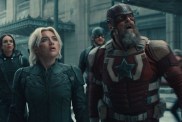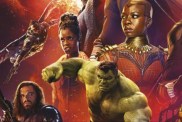Every year, when the ribbon is officially cut on the Sundance Film Festival with the Opening Day Press Conference at the Egyptian, something is happening across Main Street that probably has many of the attending press somewhat mystified. It’s called “New Frontiers on Main” and it’s essentially a series of art installations that explore the merging of film, art, technology and science.
The first time I went to check out the vast space on the lower level of 333 Main Street, I really didn’t understand the point of what they were trying to do. Admittedly, the draw this year was the free food and the wristbands that allowed priority seating at the press conference later. Let’s face it, food can get pretty expensive for a journalist/critic when it comes down to it, and once the festival kicks into overdrive, it’s rare that one gets to sit down, relax and have a decent meal.
On first entering the space, the lack of light is somewhat jarring, as are the environmental nature sounds being pumped through speakers around the space. Even more than the last time we attended, the whole thing seemed highly pretentious much like the New York art galleries that try to make every piece of work seem important or groundbreaking.
After I’d eaten, there was an informal press conference to introduce the installation’s curator Shari Frilot, and about a dozen of the artists, filmmakers and scientists represented at this year’s “New Frontier at Main.” They each talked about how their work was meant to interact with the users in a way that shifts the focus from what’s on screen to who is watching it and how they’re changing the experience.
This got me slightly more interested in what they were trying to do, so when the press conference ended, I mosied around the space that essentially felt like a cross between an art installation and a science lab, and actually found some cool things worth writing about.
Probably the coolest of them was Oblong Studio’s installation of something called “Tamper,” subtitled “Gestural Interface for Cinematic Design.” The reference to Steven Spielberg’s “Minority Report” in the description is fairly close to accurate, since this is essentially software that allows the user to manipulate images and information using gloves they motion in the air. The room in which they were demoing “Tamper” had sensor scanners every few feet along the ceiling and in the center was a dias where one of the operators, wearing a white lab coat of course, was using the sensor-covered gloves to manipulate images projected onto a screen. Not being a video editor myself, I couldn’t follow exactly what they were doing, but it certainly felt like a more tactile way of editing films than just using a mouse and keyboard. The key is that Oblong are scientists and software developers but they’re creating something that could easily be used by filmmakers. (You can check out a video of Tamper in use here.)

Another scientific-based installation nearby was Jonathan Harris and Sep Kamvar’s “We Feel Fine,” an idea so deep and intricate that it’s hard to explain and do it justice, although I’ll try. When you walk up to the computer monitor, it’s filled with literally thousands of colored balls bouncing around the screen, colliding with each other, huddling into groups, and it just looks like a very pretty random screensaver. Then you start clicking on each ball with the mouse and statements and expressions appear at the top of the screen. Apparently, these two computer scientists set up a website somewhere that allowed people from all over the world to enter text on how they’re feeling at any given moment with statements like “I feel absent” or “I am feeling sad” and then the system takes all of those expressions, catalogues them and visualizes them. It allows those reading to filter out the expressions by gender or subject matter, and it’s something that one could play around with for hours and not fully comprehend.
On the slightly more conventional side of things was Candice Breitz’s intriguing installation “Mother + Father,” set up in two adjacent darkened theaters with six monitors each. On each monitor, one could see a well-known actor in character talking about parenthood. In one room, there was Steve Martin, Donald Sutherland, Tony Danza, Harvey Keitel and two others in clips cleverly chopped together by Breitz to make it seem as if they’re having a conversation, done in a rhythmic way. The other room had the likes of Meryl Streep, Julia Roberts and others doing the same thing, using movie clips where they played mothers. We remained in each room for ten minutes or more, watching these actors interacting, never quite certain how long each looped segment lasted, but it was fairly hypnotic.
Even though we didn’t get a chance to see much, there were other experimental cinema installations that will run in the space’s “microcinema” throughout the festival. One of the artists being showcased is Maria Marshall, an artist from London, and the other is New York performance artist Michael Portnoy’s “Provocateur,” a live television show involving guests from the festival community. Though I didn’t actually see it, I was curious about Mike Plante’s “Lunchfilm: Film Before Food,” an experiment where he takes various filmmakers out to lunch in exchange for commissioned films. The catch is that the films have to cost the same amount as the lunch.
So ultimately, what seemed like pretentious claptrap at first glance ended up being a fairly cool and entertaining experience, a place where one can probably spend hours absorbing all the different ideas being expressed by the artists on display.
If you have some time to kill on Main Street over the next week, try to swing by the New Frontier space at 333 Main Street. Besides having laptops set up with free wi-fi (for those important Facebook and Twitter status updates), there’s also a lot of cool and interesting stuff that you’re not likely to see anywhere again.









